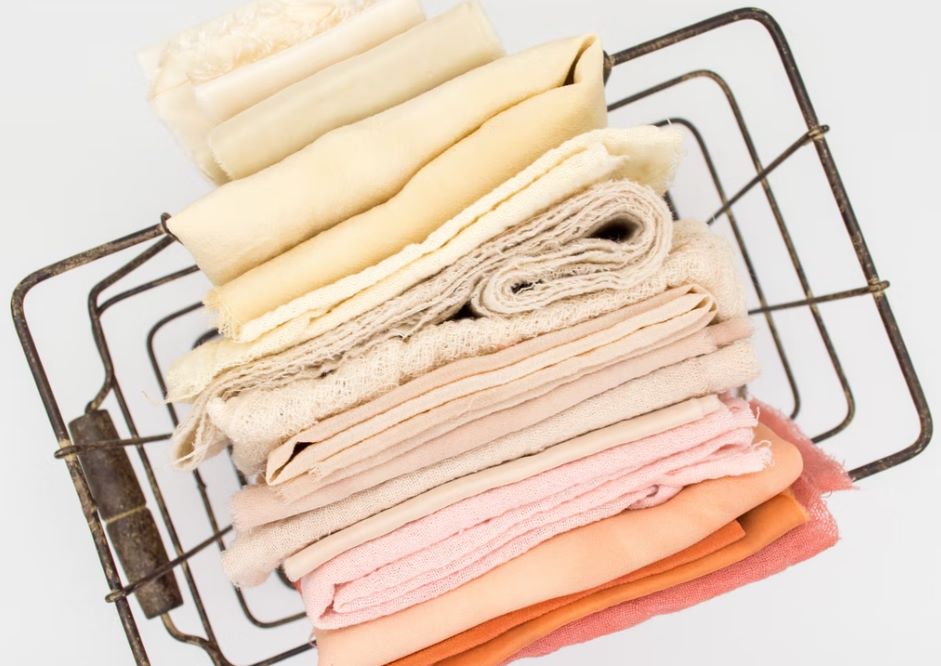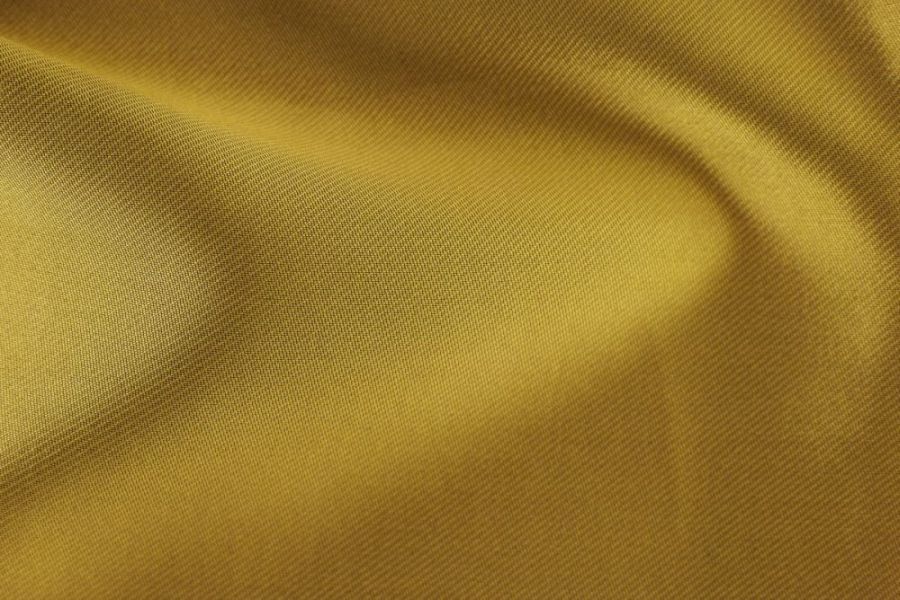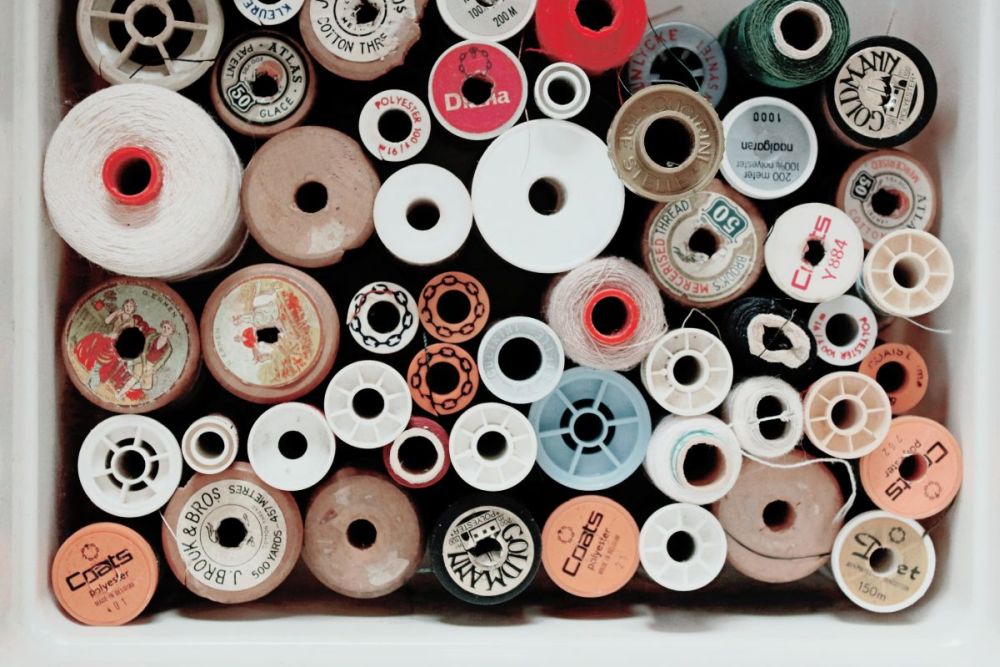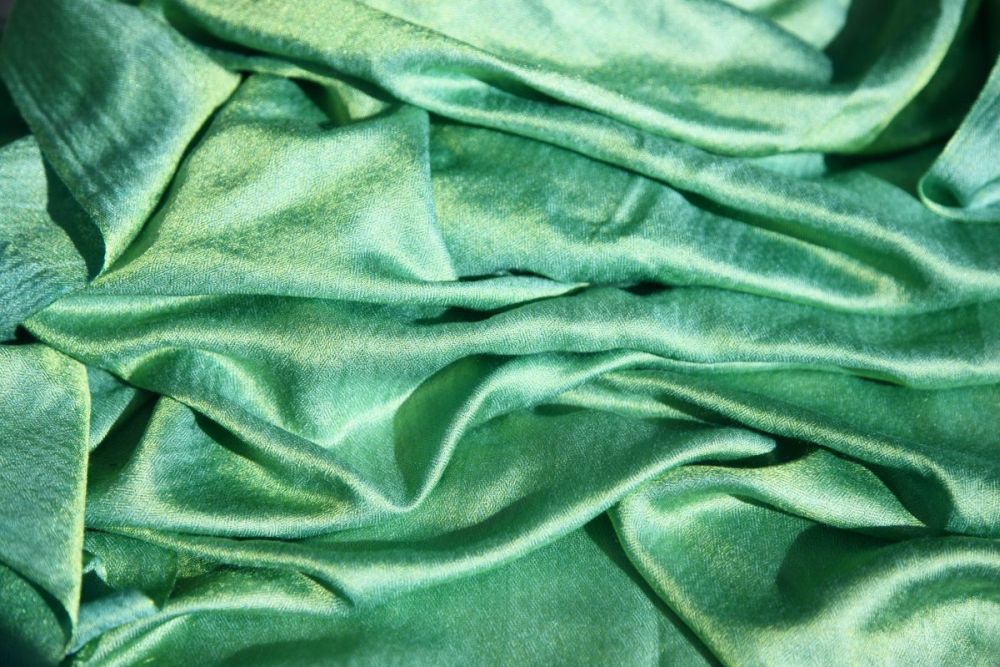Textiles that have been recycled are those that can be used again despite their age. People need to know about fabric recycling because it can help them save both money and resources. However, it is not always feasible or desirable to repurpose fabric into new clothing or other items. Instead, you can recycle fabric by cutting out patches from old garments to sew onto new ones, by using leftover fabric from another project, or by taking your old clothes to a tailor to be repurposed.
Fabrics can be made from either natural or synthetic fibres, and both types find widespread application beyond the realm of clothing. Recycled fabric refers to textiles that have been collected, sorted, and graded for reuse in the production of new fabrics.
Synthetic fibres, or man-made fibres like Polyester and Nylon, dominate the market and are widely adopted around the world. Since 2002, polyester fibre demand has been significantly higher than that of any other natural or manufactured fibre, and this trend is expected to continue.
Fabric production uses up a lot of resources like water and chemical, as well as fossil fuels, so fabrics made from regular polyester fibre are not eco-friendly. The raw materials and by-products also pose health risks due to their toxicity, environmental damage (air and water pollution), and other negative impacts. Thus, businesses have developed methods to produce polyester from previously used materials such as plastic bottles or polyester fabric.
Other types of synthetic fibres, such as nylon and spandex, have also been recycled to great effect, allowing for the production of recycled fabrics that would otherwise have ended up in a landfill. Use of recycled fabrics is highly significant due to the positive effects on the economy and the environment.
What Variation Do Recycled Fabrics Come From?
The recycling process and techniques are examined by using recycled polyester fabrics as an example. The PET (polythene terephthalate) used to make the recycled polyester fabric comes from previously used plastic bottles. Compared to virgin polyester, which must be extracted from the environment, recycled polyester requires 33–33% less energy. Producing recycled polyester also doesn't call for vast swaths of land or gallons of water like cotton does.
Used polyester fabrics can also be recycled into new fabrics; typically, the garments are shredded into shreds before being repurposed. Fabric scraps are granulated into polyester chips. The chips are then melted down and re-spun into filament fibres for use in the production of new polyester textiles.
RPET (recycled polythene terephthalate) can come from two different places: either from consumers or factories. Additionally, a small percentage of RPET can be sourced from the waste products of fibre and yarn manufacturers who sell to the garment manufacturing or retail sector. The post-consumer RPET comes from recycled plastic bottles, while the post-industrial RPET is sourced from surplus packaging materials and industrial by-products.
RPET Fabric Production and Recycling Process:
- To facilitate shipment, plastic bottles are crushed and packed into cartons using baling.
- In the fibre extrusion process, the dried flakes are first stretched out and then cut into PET pellets.
- Recyling of plastic bottles: Most of this comes from the sea.
- These pellets are then fed into a "spinneret," where they are heated and stretched into fine string-like fibres used in yarn spinning and garment production. Polyester yarn is made by spinning and then spinning the fibres together. Once the fibre has been cleaned, it will be stretched out and wound onto a large reel, then delivered to a fabric manufacturer to be used in the final product.
- Infrared (NIR) sorting devices are used to remove anything that isn't plastic, as any errors that make it past the system lower product quality.
How Do I Recycle Fabrics?
Donating clothing to a local church, organisation, non-profit, or thrift store is a great first step if you're interested in fabric recycling. Then, you can choose to recycle your fabric and fabric scraps if you don't want to donate them or if donating them isn't possible for you.
It's not possible to generalise about fabric recycling, but in most major cities, there are programmes that collect and repurpose textiles. Make sure your fabric is in good shape before contacting a textile recycling programme.
That is not to say, however, that your fabrics must be pristine and barely used. Even the filthiest, most worn underwear can be put to good use again. To recycle successfully, however, you must first make sure that your textiles are free of dirt and moisture. Make sure the fabric you intend to recycle is dry and has been cleaned before you attempt to recycle it. Wet, mouldy, or otherwise unclean fabric dumped into a recycling bin full of clean, dry fabric could contaminate the whole bin.
Bacteria can multiply in damp fabrics and spread to other items. Not only can the recycled fabric spread the bacteria to other textiles, but it is shipped in bales to prevent the spread. Those bales may spontaneously catch fire due to the bacteria. To sum up, before submitting fabric to a recycling programme, make sure it has been thoroughly cleaned and is completely dry.
What Are The Environmental Benefits Of Recycled Fabrics?
Recycled fabrics made from rPET help the environment by drastically cutting down on things like trash in landfills, pollution, and energy consumption. When compared to the production of virgin materials, the use of recycled fabrics in manufacturing processes or consumption cycles results in a significant reduction of carbon dioxide emissions.
Garments made from recycled polyester have the added benefit of being recyclable multiple times with minimal to no loss in quality. Polyester's non-biodegradability is an advantage over biodegradable fibres. Natural fibres like cotton and wool can't be recycled like polyester can, and even though they decompose over time, it can take a long time. In contrast to polyester fabrics that can be recycled, wool produces methane during the decomposition process, which has a warming effect on the planet.
Recycled fabrics are more morally sound than silk because they do not harm living things. Fabrics made from recycled materials help ease the strain on natural resources and the oil and other chemicals used in the production of synthetic fibres.
Is Recycled Fabric Sustainable Fabric or Not?
The sustainability movement has attracted the attention of many businesses. This is because, in the modern era, sustainability is no longer a luxury but a necessity. As a whole, humanity is aware of the devastating effects human activity is having on Earth and its ecosystems. Using sustainable fabrics is a small way that everyone can help protect the planet and its resources.
The practise of recycling has long been held up as one that is kind to the planet.
Used clothing is just as eco-friendly as new. The market is a great place to find recycled fabric. They are crafted from donated clothing that would have otherwise been thrown away. Charity donations are typically recycled. Not even if the owners decide they no longer want those clothes will they be thrown away.
Sustainability and eco-activism advocates tend to favour recycled textiles and clothing. As part of one's education, the wearing of secondhand garments becomes an option. The three R's of sustainability—reduce, reuse, and recycle—are often used as an aphorism. By recycling, one ensures that the fabric continues to exist even after it has been discarded. Producing garments in this manner also has the added benefit of being environmentally friendly.
Utilizing previously-owned garments reduces the demand for new fabric. Nearly 65% of the world's fibre production is made up of synthetic fibres. They use up a lot of oil, though, and that's a finite resource. Cotton, silk, wool, and other natural fibres also require conservation efforts. Fabrics can last longer if they are made from recycled materials.
According to research, consumers discard enormous quantities of used clothing and other textiles every year. Nearly half of all garbage is recycled and turned into new products. The majority of its sales are to developing nations. Unfortunately, not all textile trash is recycled. Recovery of this type of waste and its processing into usable recyclables is a current area of focus.
As more trash gets turned into usable recycled textiles, less trash needs to be thrown away. Otherwise, unwanted textiles would have been dumped on the ground. Less garbage will need to be buried or burned because of recycling. Some fabrics frequently use chemicals in their processing that do not biodegrade. Recycling is especially important for these types of fabrics. These kinds of sustainable practises are good for the planet.
Maintaining a low price point while still being environmentally responsible is a must. To be considered a sustainable fabric, the price tag must be reasonable. The use of recycled materials can be included here because it helps keep the cost of certain textiles down. It saves money for buyers because it doesn't call for any or very few raw materials.
It's generally accepted that the production of a fabric from recycled fibres requires less energy. To give just one example, the energy needed to produce an item of clothing from recycled polyester is 33%-53% lower than from virgin polyester. Even more so, studies show that energy consumption on Earth's surface is responsible for nearly 85% of the climatic changes. For this reason, cutting back on energy use is good for Mother Nature.
At first, the recyclables are separated into three piles: two for wearable items and one for non-wearable items. Again, they are sorted by type of material and hue. Fibers are yanked out of the fabric. These fibres are then processed through a cleaning and, if necessary, blending procedure. Yarn is produced by spinning the fibre. After the yarn has been woven, dyed, and printed, it is ready to be sewn into garments.
There are multiple facilities that can recycle your unwanted clothing. Clothes recycling is a common practise among charity organisations that receive large quantities of used clothing donations. They dispose of unwanted or extra clothing in recycling centres. In exchange, they are compensated monetarily. According to research, reusing clothing significantly reduces carbon dioxide emissions.
Recycling textiles is undeniably an environmentally responsible activity. It's good for nature to act in this way. In the textile industry, it is strongly suggested. It's a small step, but it'll help lessen the environmental damage caused by manufacturing. As a result, the production of textiles will be cheaper. Recycling is an important part of making the world a more sustainable place.
FAQs About Recycled Fabrics
Polyester clothing produces huge amounts of waste and pollutes the air, soil, and water with plastic microfibers and hazardous chemicals. A more environmentally friendly alternative to polyester is recycled polyester (rPET). It’s manufactured from PET bottles, post-industrial polyester waste, or used clothing.
If all the steps were followed properly, is the end recycled polyester product, whether a swimsuit or shoe, safe to wear? In short: yes, it’s safe to wear clothing, even underwear, made from post-consumer plastic water bottles.
However, the catch is that while PET itself is safe to wear, dyes, and other finishing processes, the natural or synthetic yarn goes through to become that shirt or bikini can still contain harmful substances.
Recycled polyester is obtained by melting existing plastic and re-spinning it into new polyester fibre. For example, five water bottles yield enough fibre for one T-shirt. Although recycling plastic sounds like a good idea, recycled polyester is far from the best sustainable fashion solution.
RECYCLED POLYESTER: THE PROS
Avoiding disposal in landfills and marine environments - Polyester, which is not biodegradable, can be recycled and used again. Without this, it would probably wind up in a landfill or the sea. More than 150 million metric tonnes of plastic are already floating around in the ocean, and another 8 million tonnes are dumped into it every year. By 2050, there will be more trash than fish in the seas if we continue on this path.
Polyester made from recycled materials is just as durable as virgin polyester but requires fewer raw materials. Recycled polyester is nearly identical in quality to virgin polyester, but it uses 59% less energy to produce. Because of this, recycled polyester producers aim to cut CO2 output by 32% in comparison to conventional polyester. Furthermore, polyester made from recycled materials can lessen the need for crude oil and natural gas used in plastic production.
RECYCLED POLYESTER: THE CONS
The fabric of many garments is a combination of polyester and other materials, making recycling plastic problematic. Then recycling them becomes more troublesome or even impossible.
Not even 100% polyester clothing can be recycled indefinitely. PET can be recycled in two different ways: mechanically and chemically. With the help of machinery, used plastic bottles can be cleaned, shredded, and transformed into polyester chips for use in the conventional fiber-making process. When a used plastic product is chemically recycled, it is broken down into its component monomers and becomes chemically identical to virgin polyester. These leftovers can be recycled into the polyester production stream. The vast majority of recycled polyester comes from mechanical processes. It's the cheaper option because it doesn't necessitate any chemicals beyond the detergents used to clean the raw materials. However, the mechanical process can reduce the fibre's strength, necessitating the addition of virgin fibre.
The environment is also affected by the process of recycling PET, as the polyester chips produced through mechanical recycling can be a wide range of colours, from crisp white to creamy yellow. Some dyers use chlorine-based bleaches to whiten the base because they have trouble achieving a white. Because of dye uptake inconsistencies, it can be difficult to achieve consistent colour from batch to batch, which can lead to excessive re-dyeing, which in turn increases the amount of water, energy, and chemicals used.
Recycled Polyester Releases Microplastics: Finally, there is a rebuttal that claims using recycled polyester prevents trash from being dumped into seas. Manufactured fabrics still contribute somewhat because they may shed microplastic fibres. There are pros and cons to using sustainable materials in fashion, but making the switch will help lessen the industry's negative impact on the planet.
Conclusion
Fabrics can be made from either natural or synthetic fibres, and both types find widespread application beyond the realm of clothing. Recycled fabric refers to textiles that have been collected, sorted, and graded for reuse in the production of new fabrics. Use of recycled fabrics is highly significant due to the positive effects on the economy and the environment. If you're looking for ways to recycle your fabric and fabric scraps, or if you don't want to donate them, there are a number of options available. RPET (recycled polythene terephthalate) can come from two different places: either from consumers or factories.
The post-consumer RPET comes from recycled plastic bottles, while the post-industrial RPET is sourced from surplus packaging materials and industrial by-products. Fabrics made from recycled polyester have the added benefit of being recyclable multiple times with minimal to no loss in quality. Before submitting fabric to a recycling programme, make sure it has been thoroughly cleaned and is completely dry. Not only can the recycled fabric spread the bacteria to other textiles, but it is shipped in bales to prevent the spread. Fabrics can last longer if they are made from recycled materials.
Producing garments in this manner also has the added benefit of being environmentally friendly. Nearly 65% of the world's fibre production is made up of synthetic fibres. Some fabrics frequently use chemicals in their processing that do not biodegrade. Recycling textiles is undeniably an environmentally responsible activity. More than 150 million metric tonnes of plastic are already floating around in the ocean, and another 8 million tonnes are dumped into it every year.
Recycling polyester is nearly identical in quality to virgin polyester, but it uses 59% less energy to produce. The vast majority of recycled polyester comes from mechanical processes. PET can be recycled in two different ways: mechanically and chemically. The mechanical process can reduce the fibre's strength, necessitating the addition of virgin fibre. There are pros and cons to using sustainable materials in fashion, but making the switch will help lessen the industry's negative impact on the planet.
Content Summary
- Textiles that have been recycled are those that can be used again despite their age.
- People need to know about fabric recycling because it can help them save both money and resources.
- However, it is not always feasible or desirable to repurpose fabric into new clothing or other items.
- Instead, you can recycle fabric by cutting out patches from old garments to sew onto new ones, by using leftover fabric from another project, or by taking your old clothes to a tailor to be repurposed.
- Fabrics can be made from either natural or synthetic fibres, and both types find widespread application beyond the realm of clothing.
- Recycled fabric refers to textiles that have been collected, sorted, and graded for reuse in the production of new fabrics.
- Fabric production uses up a lot of resources like water and chemical, as well as fossil fuels, so fabrics made from regular polyester fibre are not eco-friendly.
- Other types of synthetic fibres, such as nylon and spandex, have also been recycled to great effect, allowing for the production of recycled fabrics that would otherwise have ended up in a landfill.
- Use of recycled fabrics is highly significant due to the positive effects on the economy and the environment.
- The recycling process and techniques are examined by using recycled polyester fabrics as an example.
- The PET (polythene terephthalate) used to make the recycled polyester fabric comes from previously used plastic bottles.
- Producing recycled polyester also doesn't call for vast swaths of land or gallons of water like cotton does.
- The chips are then melted down and re-spun into filament fibres for use in the production of new polyester textiles.
- RPET (recycled polythene terephthalate) can come from two different places: either from consumers or factories.
- Additionally, a small percentage of RPET can be sourced from the waste products of fibre and yarn manufacturers who sell to the garment manufacturing or retail sector.
- The post-consumer RPET comes from recycled plastic bottles, while the post-industrial RPET is sourced from surplus packaging materials and industrial by-products.
- Donating clothing to a local church, organisation, non-profit, or thrift store is a great first step if you're interested in fabric recycling.
- Then, you can choose to recycle your fabric and fabric scraps if you don't want to donate them or if donating them isn't possible for you.
- Make sure your fabric is in good shape before contacting a textile recycling programme.
- Not only can the recycled fabric spread the bacteria to other textiles, but it is shipped in bales to prevent the spread.
- Those bales may spontaneously catch fire due to the bacteria.
- To sum up, before submitting fabric to a recycling programme, make sure it has been thoroughly cleaned and is completely dry.
- Recycled fabrics made from rPET help the environment by drastically cutting down on things like trash in landfills, pollution, and energy consumption.
- When compared to the production of virgin materials, the use of recycled fabrics in manufacturing processes or consumption cycles results in a significant reduction of carbon dioxide emissions.
- Garments made from recycled polyester have the added benefit of being recyclable multiple times with minimal to no loss in quality.
- Recycled fabrics are more morally sound than silk because they do not harm living things.
- Fabrics made from recycled materials help ease the strain on natural resources and the oil and other chemicals used in the production of synthetic fibres.
- The sustainability movement has attracted the attention of many businesses.
- Using sustainable fabrics is a small way that everyone can help protect the planet and its resources.
- The practise of recycling has long been held up as one that is kind to the planet.
- Used clothing is just as eco-friendly as new.
- The market is a great place to find recycled fabric.
- By recycling, one ensures that the fabric continues to exist even after it has been discarded.
- Producing garments in this manner also has the added benefit of being environmentally friendly.
- Utilizing previously-owned garments reduces the demand for new fabric.
- Nearly 65% of the world's fibre production is made up of synthetic fibres.
- Fabrics can last longer if they are made from recycled materials.
- According to research, consumers discard enormous quantities of used clothing and other textiles every year.
- Nearly half of all garbage is recycled and turned into new products.
- Unfortunately, not all textile trash is recycled.
- As more trash gets turned into usable recycled textiles, less trash needs to be thrown away.
- Less garbage will need to be buried or burned because of recycling.
- Recycling is especially important for these types of fabrics.
- These kinds of sustainable practises are good for the planet.
- Maintaining a low price point while still being environmentally responsible is a must.
- To be considered a sustainable fabric, the price tag must be reasonable.
- The use of recycled materials can be included here because it helps keep the cost of certain textiles down.
- It's generally accepted that the production of a fabric from recycled fibres requires less energy.
- There are multiple facilities that can recycle your unwanted clothing.
- Clothes recycling is a common practise among charity organisations that receive large quantities of used clothing donations.
- They dispose of unwanted or extra clothing in recycling centres.
- According to research, reusing clothing significantly reduces carbon dioxide emissions.
- Recycling textiles is undeniably an environmentally responsible activity.
- It's good for nature to act in this way.
- In the textile industry, it is strongly suggested.
- It's a small step, but it'll help lessen the environmental damage caused by manufacturing.
- As a result, the production of textiles will be cheaper.
- Recycling is an important part of making the world a more sustainable place.
- Avoiding disposal in landfills and marine environments - Polyester, which is not biodegradable, can be recycled and used again.
- More than 150 million metric tonnes of plastic are already floating around in the ocean, and another 8 million tonnes are dumped into it every year.
- Polyester made from recycled materials is just as durable as virgin polyester but requires fewer raw materials.
- Recycled polyester is nearly identical in quality to virgin polyester, but it uses 59% less energy to produce.
- Because of this, recycled polyester producers aim to cut CO2 output by 32% in comparison to conventional polyester.
- Furthermore, polyester made from recycled materials can lessen the need for crude oil and natural gas used in plastic production.
- The fabric of many garments is a combination of polyester and other materials, making recycling plastic problematic.
- Then recycling them becomes more troublesome or even impossible.
- Not even 100% polyester clothing can be recycled indefinitely.
- PET can be recycled in two different ways: mechanically and chemically.
- With the help of machinery, used plastic bottles can be cleaned, shredded, and transformed into polyester chips for use in the conventional fiber-making process.
- These leftovers can be recycled into the polyester production stream.
- The vast majority of recycled polyester comes from mechanical processes.
- The environment is also affected by the process of recycling PET, as the polyester chips produced through mechanical recycling can be a wide range of colours, from crisp white to creamy yellow.
- Finally, there is a rebuttal that claims using recycled polyester prevents trash from being dumped into seas.
- There are pros and cons to using sustainable materials in fashion, but making the switch will help lessen the industry's negative impact on the planet.







